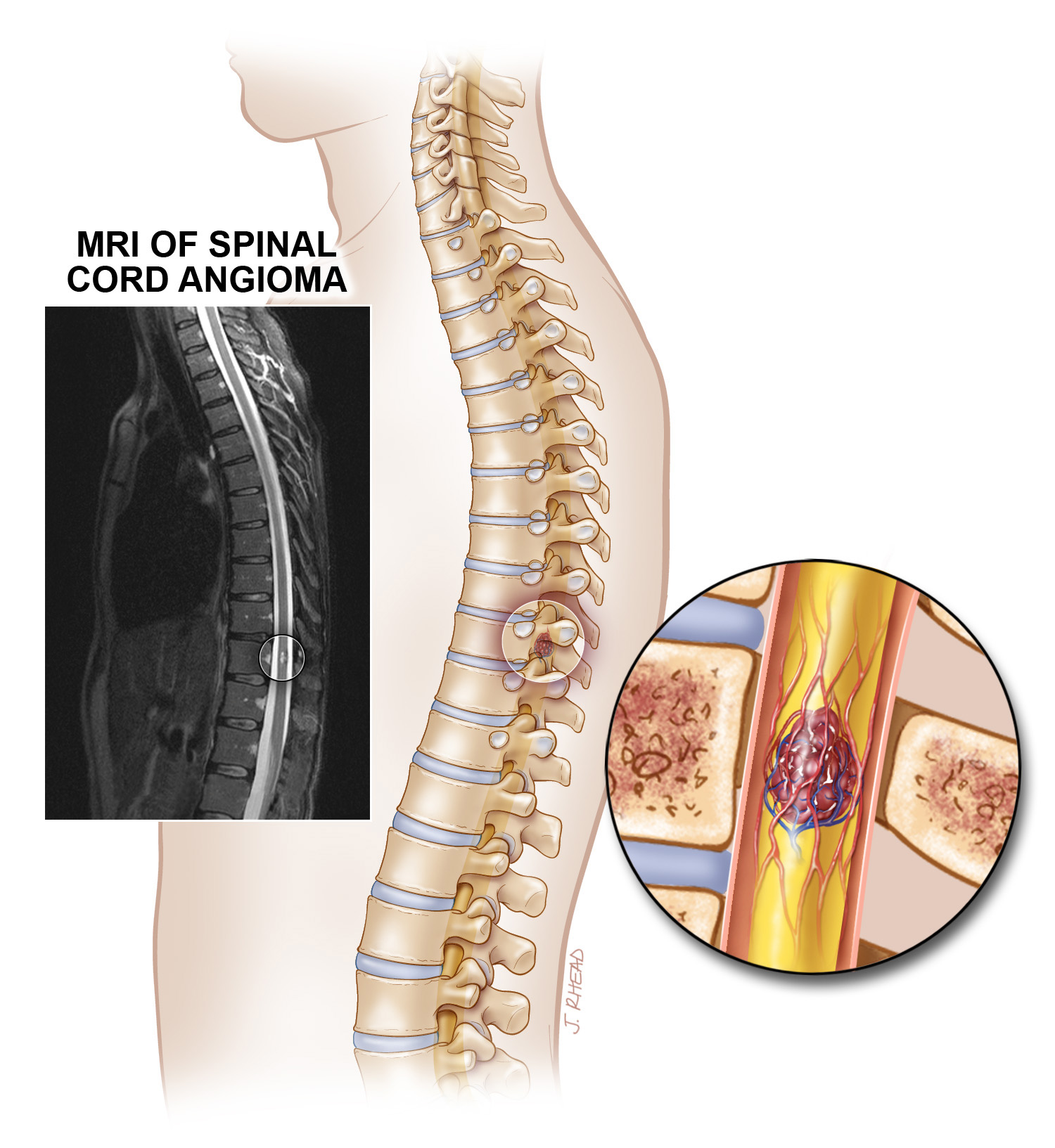It’s difficult for us to know the exact number of people who have a lesion in the spinal cord. This is because people with familial cavernous malformations may have lesions in both their brain and spinal cord, but they typically do not get spinal imaging unless they become symptomatic.
Spinal cord cavernous malformations should not be confused with spinal hemangioma. Spinal hemangiomas are lesions in the vertebra – the bone – that are not typically symptomatic and are common in the general population.

A meta-analysis (Bhadawali, 2014) that included 632 patients with spinal cord cavernous malformation provides us with the most comprehensive profile to date.
In the 40 studies the authors compiled, they found the following:
Location of the lesion:
- Cervical or cervicothoracic 40.4%
- Thoracic or thoracolumbar 55.8%
- Lumbar or conus medullaris 3.8%
Size
The average size of the spinal lesion was 9.2 mm.
Other lesions/family history
- 16.5% have lesions in the brain as well
- 11.9% had a family history of the illness
Course of the illness
- After the initial event that led to their diagnosis, 45.4% of patients tended to experience additional symptoms in acute flare-ups with a resulting stepwise decline in their functioning.
- For 54.6% of patients, their initial event was followed by a slow, progressive decline in functioning over the course of years.
Symptoms
Patients reported the following symptoms. Many patients experienced more than one symptom.
- Motor (weakness) 60.5%
- Sensory (tingling, numbness) 57.8%
- Pain 33.8%
- Bladder and/or bowel issues 23.6%
- Respiratory distress 0.5%
- Asymptomatic 0.9%
Hemorrhage
The calculated pooled annual rate of hemorrhage was 2.1%. This is quite low but the authors did not differentiate between lesions that had previously hemorrhaged versus those that had never hemorrhaged. We know in brain lesions, lesions that have previously hemorrhaged have dramatically higher hemorrhage rates in the first 2-5 years after the initial hemorrhage.
Surgery
In these studies, almost 90% of patients had surgery and those who had surgery tended to do better than those who were conservatively managed (but we don’t know whether these conservatively managed patients had lesions in more dangerous locations).
Better outcomes after surgery were correlated with:
- Surgery within 3 months of symptom onset
- Acute clinical course
- Motor symptoms
Less recovery after surgery was correlated with having sensory symptoms (tingling, numbness).
In this meta-analysis, the rate of improvement after surgery did not differ between those who had superficial lesions versus those who had lesions deeper in their spinal cord.
PATIENT STORY: Joyce
 Spinal Cavernous Malformation
Spinal Cavernous Malformation
“I had just put my left arm down on the kitchen table when I experienced this intense pain from the tips of my fingers to my elbow,” Joyce told the New York Times in a 2007 interview. “It felt like my whole arm was burning.”
It would be years before doctors accurately diagnosed Joyce with a cavernous malformation in her cervical spinal cord. By that time, the pain had spread to her right arm. Her surgeon told her the lesion was accessible, and Joyce had successful surgery in 2004. The surgery helped to resolve some of Joyce’s pain and prevented any further escalation.
Joyce also has multiple cavernous malformations in her brain. This is because of a hereditary genetic change known as the Common Hispanic Mutation. While anyone of any ethnicity can have a hereditary form of cavernous malformation illness, thousands of people who trace their heritage to the original Spanish settlers of New Mexico share this specific genetic mutation. A single ancestor connects them all, and many of these families have remained in New Mexico, including Joyce. No other place in the world has as many affected people. Joyce has been active in advocacy and in raising awareness of the illness throughout New Mexico.
In addition to the New York Times interview, Joyce was central in drafting legislation in New Mexico that created a mandate to educate more doctors. Joyce has presented at patient conferences and worked with media around the state to share her story and the genealogy she has researched. Joyce was happy to discover that neither of her children inherited the illness. In Joyce’s family, the Common Hispanic Mutation has stopped with her, though her work toward further research and a cure continues.
Support
Alliance to Cure Cavernous Malformation offers a quarterly online support group specifically for those with spinal cord lesions. Please contact us at info@alliancetocure.org for information on participating in this group. We also host the private Spinal Cavernous Malformation Facebook group.
Updated 4.16.22

 Spinal Cavernous Malformation
Spinal Cavernous Malformation